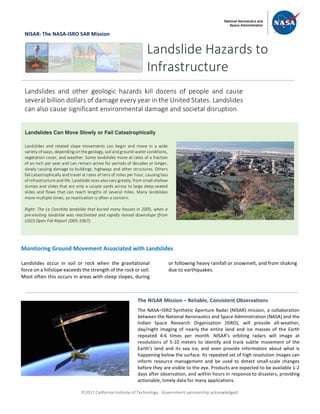
NISAR NASA-ISRO Synthetic Aperture Radar (NISAR) Landslides
- 1. ã2017 California Institute of Technology. Government sponsorship acknowledged. NISAR: The NASA-ISRO SAR Mission Monitoring Ground Movement Associated with Landslides Landslides occur in soil or rock when the gravitational force on a hillslope exceeds the strength of the rock or soil. Most often this occurs in areas with steep slopes, during or following heavy rainfall or snowmelt, and from shaking due to earthquakes. Landslide Hazards to Infrastructure Landslides and other geologic hazards kill dozens of people and cause several billion dollars of damage every year in the United States. Landslides can also cause significant environmental damage and societal disruption. Landslides Can Move Slowly or Fail Catastrophically Landslides and related slope movements can begin and move in a wide variety of ways, depending on the geology, soil and ground-water conditions, vegetation cover, and weather. Some landslides move at rates of a fraction of an inch per year and can remain active for periods of decades or longer, slowly causing damage to buildings, highways and other structures. Others fail catastrophically and travel at rates of tens of miles per hour, causing loss of infrastructure and life. Landslide sizes also vary greatly, from small shallow slumps and slides that are only a couple yards across to large deep-seated slides and flows that can reach lengths of several miles. Many landslides move multiple times, so reactivation is often a concern. Right: The La Conchita landslide that buried many houses in 2005, when a pre-existing landslide was reactivated and rapidly moved downslope (from USGS Open File Report 2005-1067). The NISAR Mission – Reliable, Consistent Observations The NASA–ISRO Synthetic Aperture Radar (NISAR) mission, a collaboration between the National Aeronautics and Space Administration (NASA) and the Indian Space Research Organization (ISRO), will provide all-weather, day/night imaging of nearly the entire land and ice masses of the Earth repeated 4-6 times per month. NISAR’s orbiting radars will image at resolutions of 5-10 meters to identify and track subtle movement of the Earth’s land and its sea ice, and even provide information about what is happening below the surface. Its repeated set of high resolution images can inform resource management and be used to detect small-scale changes before they are visible to the eye. Products are expected to be available 1-2 days after observation, and within hours in response to disasters, providing actionable, timely data for many applications. .
- 2. ã2017 California Institute of Technology. Government sponsorship acknowledged. Continued from front page Landslides in the last few years have caused widespread fatalities and major damage in the United States. During a two-year period between 2014 and 2016, 61 people were killed, including 43 in the Oso landslide in Washington State (Coe, 2016). Globally, between 2000 and 3000 people are killed by landslides every year (Petley, 2017). NISAR will be able to measure ground surface movement directly through repeat imaging of landslide prone regions and processing the sequence of images using synthetic aperture radar interferometry (InSAR), which can measure changes in the distance between the radar antenna and the ground at the scale of a fraction of an inch. One major advantage of InSAR is that it can be used to measure surface deformation directly across large areas (hundreds of miles) with far greater accuracy than is possible with other commonly used remote sensing or ground-based monitoring techniques (e.g., GPS surveying). Radar has additional advantages over ground- based and optical methods, the most significant of which is the ability to see through clouds, smoke, and haze, and the ability to image the ground surface during day or night without relying on solar illumination. All NISAR data products, including the products showing surface movement, will be freely available through a web portal. This way, the nation’s investment in land surveys remotely acquired from space can be widely used by a variety of agencies and individuals to detect landslide movement when it begins to happen, and potentially prevent further landslide movement from causing human and economic disasters. National Aeronautics and Space Administration For more information, visit http://nisar.jpl.nasa.gov/applications Jet Propulsion Laboratory / California Institute of Technology / Pasadena, California / www.jpl.nasa.gov Map showing areas of the conterminous United States with negligible (gray) and some (red) susceptibility to landslides [Modified from Godt et al., 2012] Some landslides move slowly over a long time, gradually damaging roads, pipes, and other infrastructure. One example is shown at the right, where ground movement of landslides in the Berkeley Hills of California between 2008 and 2010 was captured using UAVSAR, NASA’s airborne prototype for the NISAR space mission. In this type of map, called an interferogram, the colors show contours of ground movement. A regular schedule of radar imaging with NISAR, which will image all the land in the United States and nearly all land globally, will enable detection of slow-moving landslides, so damage can be avoided, and potentially provide forewarning of rapid landslides in the weeks to months prior to their catastrophic failure. As a result, these relatively common and highly destructive geologic hazards will be identified more quickly, efficiently, and economically, helping scientists, engineers, and policy makers protect lives and property. Monitoring Landslide Motion with Radar
